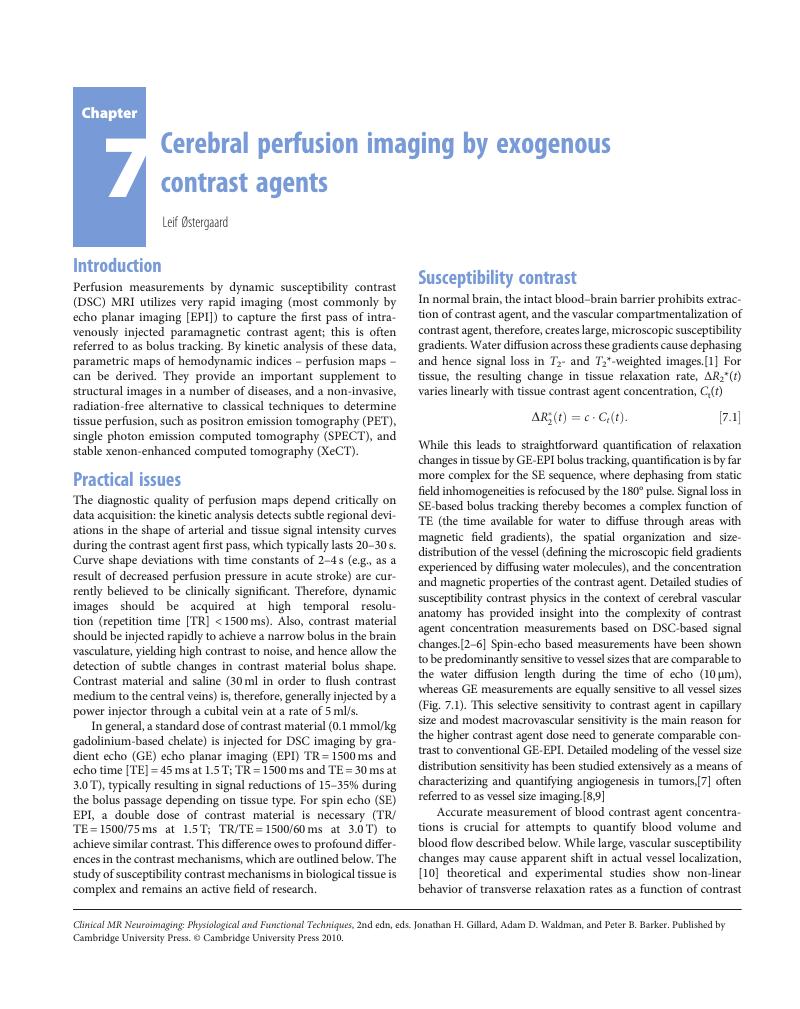Book contents
- Frontmatter
- Contents
- Contributors
- Case studies
- Preface to the second edition
- Preface to the first edition
- Abbreviations
- Introduction
- Section 1 Physiological MR techniques
- Chapter 1 Fundamentals of MR spectroscopy
- Chapter 2 Quantification and analysis in MR spectroscopy
- Chapter 3 Artifacts and pitfalls in MR spectroscopy
- Chapter 4 Fundamentals of diffusion MR imaging
- Chapter 5 Human white matter anatomical information revealed by diffusion tensor imaging and fiber tracking
- Chapter 6 Artifacts and pitfalls in diffusion MR imaging
- Chapter 7 Cerebral perfusion imaging by exogenous contrast agents
- Chapter 8 Detection of regional blood flow using arterial spin labeling
- Chapter 9 Imaging perfusion and blood–brain barrier permeability using T1-weighted dynamic contrast-enhanced MR imaging
- Chapter 10 Susceptibility-weighted imaging
- Chapter 11 Artifacts and pitfalls in perfusion MR imaging
- Chapter 12 Methodologies, practicalities and pitfalls in functional MR imaging
- Section 2 Cerebrovascular disease
- Section 3 Adult neoplasia
- Section 4 Infection, inflammation and demyelination
- Section 5 Seizure disorders
- Section 6 Psychiatric and neurodegenerative diseases
- Section 7 Trauma
- Section 8 Pediatrics
- Section 9 The spine
- Index
- References
Chapter 7 - Cerebral perfusion imaging by exogenous contrast agents
from Section 1 - Physiological MR techniques
Published online by Cambridge University Press: 05 March 2013
- Frontmatter
- Contents
- Contributors
- Case studies
- Preface to the second edition
- Preface to the first edition
- Abbreviations
- Introduction
- Section 1 Physiological MR techniques
- Chapter 1 Fundamentals of MR spectroscopy
- Chapter 2 Quantification and analysis in MR spectroscopy
- Chapter 3 Artifacts and pitfalls in MR spectroscopy
- Chapter 4 Fundamentals of diffusion MR imaging
- Chapter 5 Human white matter anatomical information revealed by diffusion tensor imaging and fiber tracking
- Chapter 6 Artifacts and pitfalls in diffusion MR imaging
- Chapter 7 Cerebral perfusion imaging by exogenous contrast agents
- Chapter 8 Detection of regional blood flow using arterial spin labeling
- Chapter 9 Imaging perfusion and blood–brain barrier permeability using T1-weighted dynamic contrast-enhanced MR imaging
- Chapter 10 Susceptibility-weighted imaging
- Chapter 11 Artifacts and pitfalls in perfusion MR imaging
- Chapter 12 Methodologies, practicalities and pitfalls in functional MR imaging
- Section 2 Cerebrovascular disease
- Section 3 Adult neoplasia
- Section 4 Infection, inflammation and demyelination
- Section 5 Seizure disorders
- Section 6 Psychiatric and neurodegenerative diseases
- Section 7 Trauma
- Section 8 Pediatrics
- Section 9 The spine
- Index
- References
Summary

- Type
- Chapter
- Information
- Clinical MR NeuroimagingPhysiological and Functional Techniques, pp. 86 - 93Publisher: Cambridge University PressPrint publication year: 2009



